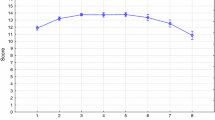Abstract
Findings in this paper show a strong correlation between subjects' age and their olfactory sensitivity to the “fishy” odor of trimethylamine, with youngest subjects being most sensitive and adult subjects least sensitive to this odor. This was due to a high percentage of highly sensitive subjects in the youngest age groups; this percentage decreased with age. Data further support the notion that trimethylamine sensitivity is independent of sex. The sensitivity to trimethylamine per se showed no significant covariations with the subjects' preferences for or aversions against fish as food and is probably of minor importance for fish food acceptability.
Similar content being viewed by others
References
Albone, E.S., andFox, M.W. 1971. Anal gland secretion of the red fox.Nature 233:569–570.
Amoore, J.E., andForrester, L.J. 1976. Specific anosmia to trimethylamine: The fishy primary odor.J. Chem. Ecol. 2:49–56.
Amoore, J.E., Venstrom, D., andDavis, A.R. 1968. Measurement of specific anosmia.Percept.Mot. Skills 26:143–164.
Castell, C.H., Smith, B., andDyer, W.J. 1974. Simultaneous measurements of trimethylamine and dimethylamine in fish, and their use for estimating quality of frozen-stored gadoid fillets.J. Fish. Res. Board Can. 31:383–389.
Fiskeridirektoratet, Avdeling for Kvalitetskontroll. 1986.Kvalitetsforskrift for Fisk og Fiskevarer 40–44.
Freier, R.K., 1976. Aqueous Solutions. Data for Inorganic and Organic Compounds, Vol. 1. Walter de Gruyter, Berlin, p. 377.
Gellermann, L.W., 1933. Chance orders of alternating stimuli in visual discrimination experiments.J. Genet. Psychol. 42:206–208.
Gilbert, A.N., andWysocki, C.J. 1987. The smell survey results.Nat. Geogr. 172:514–525.
Huss, H.H. 1983. Fersk Fisk-Kvalitet og Holdbarhed. Fiskeriministeriets Forsøgslaboratorium, Lyngby.
Jellestad, F.K., andSolbu, E.H. 1987. Barns forhold til fisk som middagsmat i norske husholdninger. Unpublished report to the Norwegian Fisheries Research Council, NFFR project III 111.002.
Jones, N.R. 1967. Fish flavors, pp. 267–295in H.W. Schultz, E.A. Day, and L.M. Libbey (eds.). Symposium on Foods: The Chemistry and Physiology of Flavors. AVI Publishing Comp., Westport, Connecticut.
Leonardos, G., Kendall, D., andBarnard, N. 1969. Odor threshold determinations of 53 odorant chemicals. J. Air Pollut. Control Assoc. 19:91–95.
(The) Merck Index. 1983. 10th ed., p. 1387. Merck & Co., Rahway, New lersey.
Murphy, C. 1987. Olfactory psychophysics,in T.E. Finger and W.L. Silver (eds.). Neurobiology of Taste and Smell. John Wiley & Sons, New York.
Pangborn, R.M., Trabue, I.M., andBarylko-Pikielna, N. 1967. Taste, odor, and tactile discrimination before and after smoking.Percept. Psychophys. 2:529–532.
Ritskes, T.M. 1975. Gas chromatographical determination of trimethylamine and dimethylamine in fish, fishery products and other foodstuffs.J. Food Technol. 10:221–228.
Shewan, J.M., Gibson, D.M., andMurray, C.K. 1971. The estimation of trimethylamine in fish muscle, pp. 183–186in R. Kreuzer (ed.). Fish Inspection & Quality Control. Fishing News Limited, London.
Smith, J.G.M., Hardy, R., Thomson, A.B., Young, K.W., andParsons, E. 1980. Some observations on the ambient and chill storage of blue whiting (Micromesistius poutassou), pp. 299–303in J.J. Connell (ed.). Advances in Fish Science and Technology. Fishing News Books Ltd., Farnham.
Standsby, M.E. 1962. Speculations on fish odors and flavors.Food Technol. 16:28–32. StatSoft, Inc., 1988. CSS (Complete Statistical System, 2nd ed.). Tulsa, Oklahoma.
Tereshchenko, A.G., andChemeris, L.A. 1975. The solubility of methylammonium halides in water in the range 0–80 °C.Russ J. Phys. Chem. 49:2457.
Venstrom, D., andAmoore, J.E. 1968. Olfactory threshold in relation to age, sex or smoking.J. Food Sci. 33:264–265.
Vierling, J.S., andRock, J. 1967. Variations in olfactory sensitivity to exaltolide during the menstrual cycle.J. Appl. Physiol. 22:311–315.
Author information
Authors and Affiliations
Rights and permissions
About this article
Cite this article
Solbu, E.H., Jellestad, F.K. & Strætkvern, K.O. Children's sensitivity to odor of trimethylamine. J Chem Ecol 16, 1829–1840 (1990). https://doi.org/10.1007/BF01020497
Received:
Accepted:
Issue Date:
DOI: https://doi.org/10.1007/BF01020497




